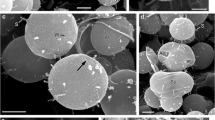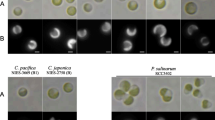Abstract
Members of the recently proposed genus Parasynechococcus (Cyanobacteria) are extremely abundant throughout the global ocean and contribute significantly to global primary productivity. However, the taxonomy of these organisms remains poorly characterized. The aim of this study was to propose a new taxonomic framework for Parasynechococcus based on a genomic taxonomy approach that incorporates genomic, physiological and ecological data. Through in silico DNA–DNA hybridization, average amino acid identity, dinucleotide signatures and phylogenetic reconstruction, a total of 15 species of Parasynechococcus could be delineated. Each species was then described on the basis of their gene content, light and nutrient utilization strategies, geographical distribution patterns throughout the oceans and response to environmental parameters.




Similar content being viewed by others
References
Al-Saari N, Gao F, Rohul AAKM, Sato K, Sato K, Mino S, Suda W, Oshima K, Hattori M, Ohkuma M, Meirelles PM, Thompson FL, Thompson C, Filho GMA, Gomez-Gil B, Sawabe T, Sawabe T (2015) Advanced microbial taxonomy combined with genome-based-approaches reveals that Vibrio astriarenae sp. Nov., an agarolytic marine bacterium, forms a new clade in Vibrionaceae. PLoS One 10:1–17
Appolinario LR, Tschoeke D, Venas T, Campeão ME, Amaral G, Leomil L, Oliveira L, Otsuki RK, Swings J, Thompson FL, Thompson CC (2016) Description of Endozoicomonas arenosclerae sp nov using a genomic taxonomy approach. Antonie van Leeuwenhoek J Microb 109(3):431–438
Brown CT, Hug LA, Thomas BC, Sharon I, Castelle CJ, Singh A, Wilkins MJ, Wrighton KC, Williams KH, Banfield JF (2015) Unusual biology across a group comprising more than 15 % of domain Bacteria. Nature 523:208–211
Coenye T, Gevers D, Van de Peer Y, Vandamme P, Swings J (2005) Towards a prokaryotic genomic taxonomy. FEMS Microbiol Rev 29:147–167
Coutinho FH, Meirelles PM, Moreira APB, Paranhos RP, Dutilh BE, Thompson FL (2015) Niche distribution and influence of environmental parameters in marine microbial communities: a systematic review. PeerJ 3:e1008
Coutinho F, Tschoeke DA, Thompson F, Thomson C (2016) Comparative genomics of Synechococcus and proposal of the new genus Parasynechococcus. PeerJ 4:e1522
Flombaum P, Gallegos JL, Gordillo RA, Rincón J, Zabala LL, Jiao N, Karl D, Li W, Lomas M, Veneziano D, Vera C, Vrugt JA, Martiny AC (2013) Present and future global distributions of the marine Cyanobacteria Prochlorococcus and Synechococcus. Proc Nat Acad Sci 110:9824–9829
Gaget V, Welker M, Rippka R, de Marsac NT (2015) A polyphasic approach leading to the revision of the genus Planktothrix (Cyanobacteria) and its type species, P. agardhii, and proposal for integrating the emended valid botanical taxa, as well as three new species, Planktothrix paucivesiculata sp. nov. Syst Appl Microbiol 38:141–158
Gevers D, Cohan FM, Lawrence JG, Spratt BG, Coenye T, Feil EJ, Stackebrandt E, Van de Peer Y, Vandamme P, Thompson FL, Swings J (2005) Re-evaluating prokaryotic species. Nat Rev Microbiol 3:733–739
Hahn MW, Jezberova J, Koll U, Saueressig-Beck T, Schmidt J (2016) Complete ecological isolation and cryptic diversity in Polynucleobacter bacteria not resolved by 16S rRNA gene sequences. ISME J. doi:10.1038/ismej.2015.237.
Hugerth LW, Larsson J, Alneberg J, Lindh MV, Legrand C, Pinhassi J, Andersson AF (2015) Metagenome-assembled genomes uncover a global brackish microbiome. Genome Biology 16(279):1–18
Iverson V, Morris RM, Frazar CD, Berthiaume CT, Morales RL, Armbrust EV (2012) Untangling genomes from metagenomes: revealing an uncultured class of marine Euryarchaeota. Science 335:587–590
Karlin S, Mrazek J, Campbel AM (1997) Compositional biases of bacterial genomes and evolutionary implications. J Bacteriol 179:3899–3913
Kim M, Oh HS, Park SC, Chun J (2014) Towards a taxonomic coherence between average nucleotide identity and 16S rRNA gene sequence similarity for species demarcation of prokaryotes. Int J Syst Evol Microbiol 64:346–351
Komárek J (2016) Review of the cyanobacterial genera implying planktic species after recent taxonomic revisions according to polyphasic methods: state as of 2014. Hydrobiologia 764(1):259–270. doi:10.1007/s10750-015-2242-0
Komárek J, Kaštovský J, Mareš J, Johansen JR (2014) Taxonomic classification of cyanoprokaryotes (cyanobacterial genera) 2014, using a polyphasic approach. Preslia 86:295–335
Konstantinidis KT, Tiedje JM (2005) Towards a genome-based taxonomy for prokaryotes. J Bacteriol 187:6258–6264
Langmead B, Salzberg SL (2012) Fast gapped-read alignment with Bowtie 2. Nat Methods 9:357–359
Luo C, Walk ST, Gordon DM, Feldgarden M, Tiedje JM, Konstantinidis KT (2011) Genome sequencing of environmental Escherichia coli expands understanding of the ecology and speciation of the model bacterial species. Proc Natl Acad Sci USA 108:7200–7205
Meier-Kolthoff JP, Auch AF, Klenk H-P, Göker M (2013) Genome sequence-based species delimitation with confidence intervals and improved distance functions. BMC Bioinform 14:60
Micallef ML, D’Agostino PM, Al-Sinawi B, Neilan BA, Moffitt MC (2015) Exploring cyanobacterial genomes for natural product biosynthesis pathways. Mar Genom 21:1–12
Palenik B, Brahamsha B, Larimer FW, Land M, Hauser L, Chain P, Lamerdin J, Regala W, Allen EE, McCarren J, Paulsen I, Dufresne A, Partensky F, Webb EA, Waterbury J (2003) The genome of a motile marine Synechococcus. Nature 424:1037–1042
Shih PM, Wu D, Latifi A, Axen SD, Fewer DP, Talla E, Calteau A, Cai F, Tandeau de Marsac N, Rippka R, Herdman M, Sivonen K, Coursin T, Laurent T, Goodwin L, Nolan M, Davenport KW, Han CS, Rubin EM, Eisen JA, Woyke T, Gugger M, Kerfeld CA (2013) Improving the coverage of the cyanobacterial phylum using diversity-driven genome sequencing. Proc Nat Acad Sci USA 110:1053–1058
Six C, Finkel ZV, Irwin AJ, Campbell DA (2007a) Light variability illuminates niche-partitioning among marine Picocyanobacteria. PLoS One 2:e1341
Six C, Thomas J-C, Garczarek L, Ostrowski M, Dufresne A, Blot N, Scanlan DJ, Partensky F (2007b) Diversity and evolution of phycobilisomes in marine Synechococcus spp.: a comparative genomics study. Genome Biol 8:R259
Sunagawa S, Coelho LP, Chaffron S, Kultima JR, Labadie K, Salazar G, Djahanschiri B, Zeller G, Mende DR, Alberti A, Cornejo-castillo FM, Costea PI, Cruaud C, Ovidio F, Engelen S, Ferrera I, Gasol JM, Guidi L, Hildebrand F, Kokoszka F, Lepoivre C (2015) Structure and function of the global ocean microbiome. Science 348:1–10
Thompson CC, Silva GG, Vieira NM, Edwards R, Vicente AC, Thompson FL (2013) Genomic taxonomy of the genus prochlorococcus. Microb Ecol 66:752–762
Varghese NJ, Mukherjee S, Ivanova N, Konstantinidis KT, Mavrommatis K, Kyrpides NC, Pati A (2015) Microbial species delineation using whole genome sequences. Nucleic Acids Res 43:6761–6771
Wang H, Fewer DP, Sivonen K (2011) Genome mining demonstrates the widespread occurrence of gene clusters encoding bacteriocins in cyanobacteria. PLoS One 6
Zangenah S, Abbasi N, Andersson AF, Bergman P (2016) Whole genome sequencing identifies a novel species of the genus Capnocytophaga isolated from dog and cat bite wounds in humans. Sci Rep 6:22919
Acknowledgments
The authors thank CNPq, CAPES and FAPERJ for support.
Author information
Authors and Affiliations
Corresponding authors
Additional information
Communicated by Erko Stackebrandt.
Electronic supplementary material
Below is the link to the electronic supplementary material.
Figure S1
Heatmap displaying the relative abundance of 15 Parasynechococcus species across 191 Tara Oceans metagenomes (SVG 1531 kb)
Table S1
Dinucleotide signature distances and in silico DNA–DNA hybridization values for the 15 Parasynechococcus genomes (TSV 3 kb)
Table S2
List of orthologous groups shared by at least two of the 15 Parasynechococcus genomes. Obtained from (Coutinho et al. 2016) (TSV 440 kb)
Table S3
List of orthologous groups that are exclusive to a single of the 15 Parasynechococcus genomes. Obtained from (Coutinho et al. 2016) (TSV 451 kb)
Table S4
Spearman correlation scores and associated p values between sample positioning along PC1 and PC2 and measured environmental parameters (TSV 2 kb)
Rights and permissions
About this article
Cite this article
Coutinho, F.H., Dutilh, B.E., Thompson, C.C. et al. Proposal of fifteen new species of Parasynechococcus based on genomic, physiological and ecological features. Arch Microbiol 198, 973–986 (2016). https://doi.org/10.1007/s00203-016-1256-y
Received:
Revised:
Accepted:
Published:
Issue Date:
DOI: https://doi.org/10.1007/s00203-016-1256-y




